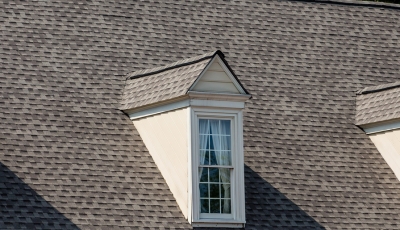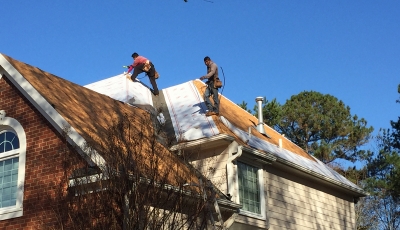If you notice water stains near your roof eaves or if you see evidence of water penetration on your home ceilings during the wintertime, you likely have roof damage from ice dams. The pros here at Falcon Homes & Remodeling are here to help with any roofing issues you may have.
What Causes Ice Dams?
If ice dams go unchecked, they can wreak havoc on your home. Ice dams weaken the structural integrity of your roof shingles and cause damaging water penetration to your home. Ice dams can wreak havoc on your roof, gutters, and home interior. They can cause your gutters to bow or break due to their denseness.
Ice dams block water from draining properly off your roof, creating a growing reservoir of water on your roof. Roof shingles are installed to protect your home, but when water gets under them due to ice dams, costly trouble follows. Unfortunately when water moves under your roof shingles, damage can occur on your roof, attic, and home interior.
When snow accumulates and creates a dam of ice, it blocks precipitation from draining off your roof like it should. When snow falls onto your roof and encounters an area of warmer surface temperature, it can cause snow to melt in that area of your roof. When the melting water gets to the edge of your roof where a lower surface temperature typically exists, it freezes and forms an ice dam.
Roof shingles tend to weaken or buckle, reducing their lifespan as a result of the heavy load of dense ice dams. The more ice builds up, the more undue weight your shingles have to carry. The good news is that ice dams can be prevented.
How to Prevent Ice Dams
To prevent ice dams, it’s vital to maintain a consistent temperature in your home attic. An even temperature in your attic decreases the freeze and thaw cycle and prevents ice dams from forming. Here are some specific things you can do to prevent ice dams from forming on your roof.
1. Verify you have the right amount of attic insulation
This is the best place to start when it comes to preventing damaging ice dams from forming on your roof. Hotspots on a roof that cause snow to melt occur because of the variation in air temperature within the attic. If an attic has adequate insulation, the heat inside will be evenly distributed.
The proper amount of attic insulation can significantly decrease the possibility of ice dam formation. The problem is that lots of homes are under-insulated. Adding spray insulation or rolled insulation to your attic is important if you currently have less than 8 inches of insulation in your attic floor. If you choose to add or roll insulation, consider laying it perpendicular to your current insulation in order to create better coverage.
2. Ensure proper ventilation to regulate attic temperature
Another important component to regulating your attic temperature is proper ventilation. Since heat rises, ventilating your roof’s ridges allows warm air to escape from your attic, preventing hotspots on your roof that could cause ice dams. Your attic vent will also help regulate the temperature inside your attic.
Ventilating your roof soffits will help cooler air to enter your attic. When the cool air circulates into your attic, it can help neutralize your house heat that often leaks into your attic, decreasing the possibility of hotspots that can lead to ice dams.
3. Seal your attic from air leaks
Prevent warm air from your home from entering your attic. If you have exhaust fans in your home bathrooms, or if you have recessed lighting, warm air can make its way from your home into your attic and cause problems like ice dams. A simple solution is to seal any areas where warm air can leak into your attic, such as any openings in your attic floor and even your attic door.
Factors to Be Aware of That May Contribute to Ice Dam Formation
Be aware of the impact of your chimney and dryer vent
When chimney or dryer vent outlets are located on your roof, heat is released from them and can melt snow, causing a thawing and refreezing process that can lead to ice dams.
Understand the effect of swift weather changes
When outdoor temperatures change quickly, ice dams can form on your roof. There’s not much we can do about rapid temperature changes during the wintertime, but it’s good to be aware they can cause ice dams to form.
What Not to Do if You Have Ice Dams Currently
It’s always better to prevent ice dams than it is to try to remove them from your roof. However, if you have ice dams currently, here’s what not to do: don’t use harsh chemicals to try to melt the ice on your roof. Chemicals can harm your roof shingles due to the corrosive properties they contain.
Secondly, you can avoid damaging your shingles by not trying to chip away at the ice dam as a DIY project. If you see ice dams on your roof, rather than trying to deal with them yourself, it’s best to contact a roofing contractor for assistance. Roofers have the training and tools to remove ice dams without damaging your roof shingles.
A Roofing Contractor You Can Trust
If you have roof damage from ice dams, contact a roofing contractor in order to get it professionally repaired. Don’t settle for subpar roof repair or replacement. If your home needs a roof replacement, the reliable team at Falcon Homes & Remodeling is ready to help. We install CertainTeed roofing, and deliver precision roof installation you can rely on.
As you take care of your roof with these valuable tips, you may notice other areas of your home such as your siding or windows that need upgrading. Don’t hesitate to reach out to us for help! We install stylish James Hardie siding, and gorgeous Vinylmax windows.



